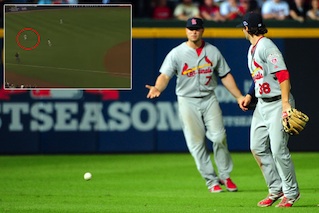When all the Turner Field trash throwing and Internet outrage had subsided on Friday night, MLB Network's Harold Reynolds offered a detailed and measured explanation of why he thought left field umpire Sam Holbrook had applied the infield fly rule call correctly. Using footage of similar calls from the past and a second-by-second breakdown of the play that helped seal Atlanta's wild card fate, Reynolds' lesson was the best I saw all night and that included the onsite press conference from Joe Torre and the umpiring crew.
Look, I can admit when I'm wrong and, after seeing the former infielder talk about the play, I think I agree that Holbrook interpreted the rule as written and that he acted no differently from a lot of routine regular season call that we never give a second thought. I still believe the rule is an ill-written one, though. The MLB rulebook defines an infield fly rule as a fly that an infielder can catch with an "ordinary effort" and there's just too much room for judgment and interpretation in that. How can you define such a play as "ordinary" when it's not immediately apparent that the infielder can make the catch? How can you apply such a routine label when a shortstop has to backpedal a significant distance while an outfielder approaches and an opposing crowd screams its head off? It seems to me that no "ordinary" play should involve so many hurdles or factors for an umpire to check off before he declares the rule in play.
I still believe the rule is an ill-written one, though. The MLB rulebook defines an infield fly rule as a fly that an infielder can catch with an "ordinary effort" and there's just too much room for judgment and interpretation in that. How can you define such a play as "ordinary" when it's not immediately apparent that the infielder can make the catch? How can you apply such a routine label when a shortstop has to backpedal a significant distance while an outfielder approaches and an opposing crowd screams its head off? It seems to me that no "ordinary" play should involve so many hurdles or factors for an umpire to check off before he declares the rule in play.
So what's the solution? I'm not sure we need one given that we wouldn't even be talking about this had St. Louis shortstop Pete Kozma made the catch. St. Louis outfielder Carlos Beltran said he had never seen anything like it, so it'll be awhile before we see it again.
If we did need one, though, I suppose it would include a definition of distance. Maybe we could the joke photo from one Redditor to help aid umpires in the future?

Are you ready for the postseason?
Follow @bigleaguestew, @KevinKaduk and the BLS Facebook page!
No comments:
Post a Comment